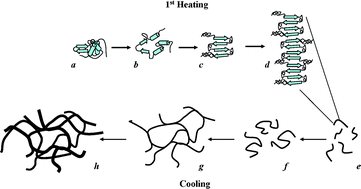Thermoreversible lysozyme hydrogels: properties and an insight into the gelation pathway†
Abstract
The

* Corresponding authors
a
School of Chemical Engineering and Analytical Science, University of Manchester, Sackville Street, Manchester, UK
E-mail:
Aline.Miller@manchester.ac.uk
Fax: +44 161 3064399
Tel: +44 161 3065781
b Jülich Centre for Neutron Science, Forschungszentrum Jülich GmbH, Garching, Germany
c Department of Engineering Physics and Mathematics and Center for New Materials, Helsinki University of Technology, P.O. Box 2200 TKK, Finland
d School of Materials, University of Manchester, Grosvenor Street, Manchester, UK
The

 Please wait while we load your content...
Something went wrong. Try again?
Please wait while we load your content...
Something went wrong. Try again?
H. Yan, H. Frielinghaus, A. Nykanen, J. Ruokolainen, A. Saiani and A. F. Miller, Soft Matter, 2008, 4, 1313 DOI: 10.1039/B716966C
To request permission to reproduce material from this article, please go to the Copyright Clearance Center request page.
If you are an author contributing to an RSC publication, you do not need to request permission provided correct acknowledgement is given.
If you are the author of this article, you do not need to request permission to reproduce figures and diagrams provided correct acknowledgement is given. If you want to reproduce the whole article in a third-party publication (excluding your thesis/dissertation for which permission is not required) please go to the Copyright Clearance Center request page.
Read more about how to correctly acknowledge RSC content.
 Fetching data from CrossRef.
Fetching data from CrossRef.
This may take some time to load.
Loading related content
